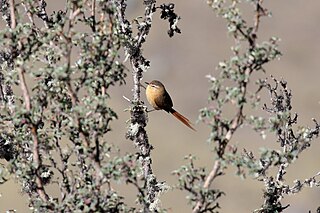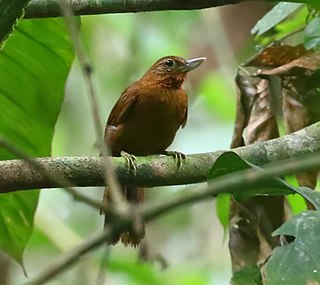
Ovenbirds or furnariids are a large family of small suboscine passerine birds found from Mexico and Central to southern South America. They form the family Furnariidae. This is a large family containing around 315 species and 70 genera. The ovenbird, which breeds in North America, is not a furnariid – rather it is a distantly related bird of the wood warbler family, Parulidae.

The Peruvian seaside cinclodes or surf cinclodes is a species of bird in the Furnariinae subfamily of the ovenbird family Furnariidae. It is endemic to Peru.

The lark-like brushrunner is a species of bird in the Furnariinae subfamily of the ovenbird family Furnariidae. It is found in Argentina, Bolivia, Brazil, Paraguay, and Uruguay.

The olive spinetail is a species of bird in the Furnariinae subfamily of the ovenbird family Furnariidae. It is found in Argentina, Brazil, and Paraguay.

The pallid spinetail is a species of bird in the Furnariinae subfamily of the ovenbird family Furnariidae. It is endemic to Brazil.

The sulphur-bearded reedhaunter or sulphur-throated spinetail is a species of bird in the Furnariinae subfamily of the ovenbird family Furnariidae. It is found in Argentina, Brazil, and Uruguay.

The tawny tit-spinetail is a species of bird in the Furnariinae subfamily of the ovenbird family Furnariidae. It is found in Argentina, Bolivia, and Peru.

The orange-breasted thornbird is a species of bird in the Furnariinae subfamily of the ovenbird family Furnariidae. It is found in Brazil, Uruguay, and possibly Argentina.

The orange-eyed thornbird is a species of bird in the Furnariinae subfamily of the ovenbird family Furnariidae. It is endemic to Brazil.

The freckle-breasted thornbird is a species of bird in the Furnariinae subfamily of the ovenbird family Furnariidae. It is found in Argentina, Brazil, Uruguay, and possibly Paraguay.

The planalto foliage-gleaner, also known as the russet-mantled foliage-gleaner, is a species of bird in the Furnariinae subfamily of the ovenbird family Furnariidae. It is found in Brazil and Paraguay.

The cinnamon-rumped foliage-gleaner is a species of bird in the Furnariinae subfamily of the ovenbird family Furnariidae. It is found in every mainland South American country except Argentina, Chile, Parguay, and Uruguay.

The Bolivian recurvebill is a bird species in the Furnariinae subfamily of the ovenbird family Furnariidae. It is found in Bolivia and Peru.

The Peruvian recurvebill is a Near Threatened species of bird in the Furnariinae subfamily of the ovenbird family Furnariidae. It is found in Bolivia, Brazil and Peru.

The spectacled prickletail is a species of bird in the Furnariinae subfamily of the ovenbird family Furnariidae. It is found in Colombia, Ecuador, and Peru.

The great spinetail is a Near Threatened species of bird in the Furnariinae subfamily of the ovenbird family Furnariidae. It is endemic to Peru.

The hoary-throated spinetail is a Critically Endangered bird species in the Furnariinae subfamily of the ovenbird family Furnariidae. It is found in Brazil and Guyana.

The rufous-necked foliage-gleaner is a Vulnerable species of bird in the Furnariinae subfamily of the ovenbird family Furnariidae. It is found in Ecuador and Peru.

The Peruvian treehunter is a species of bird in the Furnariinae subfamily of the ovenbird family Furnariidae. It is found in Bolivia and Peru. It is also called the rufous-backed treehunter or buff-throated treehunter.

The rufous-tailed xenops is a species of bird in the Furnariinae subfamily of the ovenbird family Furnariidae. It is found in Bolivia, Brazil, Colombia, Ecuador, Guyana, Peru, Suriname, Venezuela, and possibly French Guiana.























